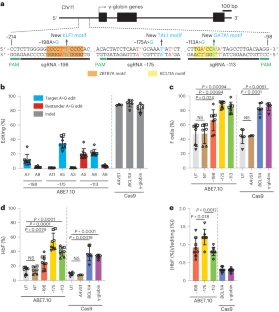Thiyagaraj Mayuranathan, Gregory A. Newby, Ruopeng Feng, Yu Yao, Kalin D. Mayberry, Cicera R. Lazzarotto, Yichao Li, Rachel M. Levine, Nikitha Nimmagadda, Erin Dempsey, Guolian Kang, Shaina N. Porter, Phillip A. Doerfler, Jingjing Zhang, Yoonjeong Jang, Jingjing Chen, Henry W. Bell, Merlin Crossley, Senthil Velan Bhoopalan, Akshay Sharma, John F. Tisdale, Shondra M. Pruett-Miller, Yong Cheng, Shengdar Q. Tsai, David R. Liu, Mitchell J. Weiss & Jonathan S. Yen
5496 Accesses, 6 Citations, 152 Altmetric
Abstract
Inducing fetal hemoglobin (HbF) in red blood cells can alleviate β-thalassemia and sickle cell disease. We compared five strategies in CD34+ hematopoietic stem and progenitor cells, using either Cas9 nuclease or adenine base editors. The most potent modification was adenine base editor generation of γ-globin –175A>G. Homozygous –175A>G edited erythroid colonies expressed 81 ± 7% HbF versus 17 ± 11% in unedited controls, whereas HbF levels were lower and more variable for two Cas9 strategies targeting a BCL11A binding motif in the γ-globin promoter or a BCL11A erythroid enhancer. The –175A>G base edit also induced HbF more potently than a Cas9 approach in red blood cells generated after transplantation of CD34+ hematopoietic stem and progenitor cells into mice. Our data suggest a strategy for potent, uniform induction of HbF and provide insights into γ-globin gene regulation. More generally, we demonstrate that diverse indels generated by Cas9 can cause unexpected phenotypic variation that can be circumvented by base editing.
This is a preview of subscription content, access via your institution.
